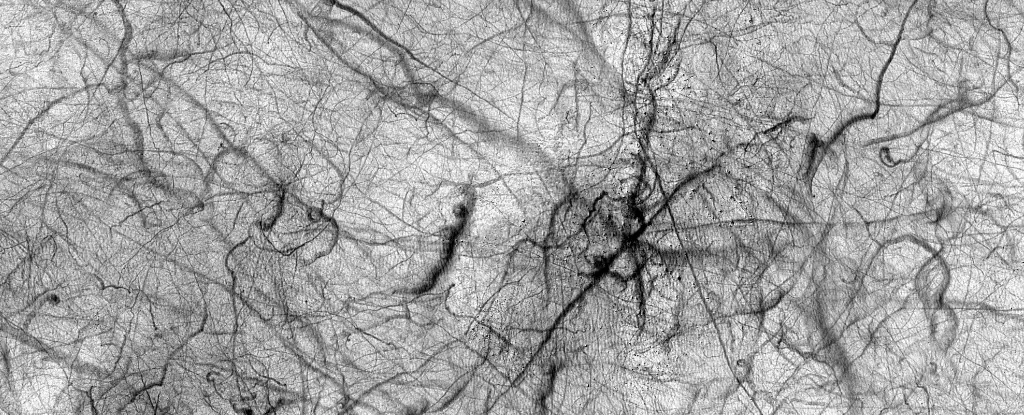Recent advancements in planetary science and imaging technology have unveiled mesmerizing snapshots of Martian dust devils, a phenomenon reflective of the dynamic nature of the Red Planet. Captured by the high-resolution camera known as HiRISE (High-Resolution Imaging Science Experiment), these whirlwinds were photographed in September 2022, showcasing their movement across the rugged terrain of Haldane Crater. The images reveal a landscape modified by countless dust devils that rise, swirl, and dissipate in the thin Martian atmosphere. Such visual documentation serves as a gateway into understanding the intricacies of Martian meteorological phenomena and the environmental conditions that shape the planet.
Dust devils on Mars are akin to their terrestrial counterparts but operate under a distinct set of atmospheric conditions. On Earth, these vortices form in warm weather when the ground heats the air above it, causing that air to rise and create a rotating column. This same process holds true on Mars but is intensified by the planet’s unique environment. Mars’ thin atmosphere, composed predominantly of carbon dioxide, is approximately 1% the density of Earth’s atmosphere, which allows for the quick formation of dust devils. As the Martian surface warms under the sun, warm air ascends rapidly, capturing finer dust particles from the ground and initiating the spinning motion characteristic of dust devils.
The implications of dust devils extend beyond mere observation; they play a crucial role in Mars’ geological and climatic systems. By redistributing dust across the planet, these phenomena influence Martian weather patterns and contribute invaluable data regarding dust accumulation rates over time. Such insights are vital not only for planetary scientists but also for engineers planning future missions to Mars, as dust accumulation can impede the functionality of rovers and instruments.
Mars, the fourth planet from the Sun, has captivated scientists and laypeople alike for centuries. Its striking reddish hue emerges from iron oxide, or rust, which blankets much of its surface. With an average temperature hovering around -60°C, Mars presents a frigid environment unfit for human habitation without advanced life-support systems. The planet features a rich tapestry of geological wonders—extensive plains, towering volcanoes like Olympus Mons, and colossal canyon systems such as Valles Marineris. These features not only illustrate Mars’ geological history but also suggest that liquid water once flowed across its surfaces, providing a crucial clue in the ongoing search for past life on the planet.
The Dual Nature of Dust Devils
Dust devils represent a paradoxical element on Mars; they act both as a natural nuisance and as a potential cleansing force. As they swirl across the landscape, dust devils can scatter particles, conveying them to regions that face solar-powered machinery such as rovers and landers. This accumulation of dust can obstruct solar panels and reduce operational efficiency, posing a significant challenge for technology deployed on Mars. However, the forceful winds generated by these atmospheric whirlwinds can also act as natural vacuum cleaners, sweeping dust off solar panels and restoring their effectiveness.
Understanding the behavior of dust devils is essential for enhancing the resilience of future Martian equipment. By studying the patterns and impacts of these swirling dust columns, engineers can devise strategies to mitigate the negative effects of dust accumulation, thereby ensuring the longevity and productivity of Martian missions.
NASA and space agencies around the globe are continuously advancing their efforts to explore Mars, driven by the desire to unlock its mysteries and seek signs of ancient life. The study of dust devils not only illuminates the ever-changing Martian landscape but also underscores the burgeoning relationship between technological exploration and planetary science. Each new image and discovery pushes the forefront of what we know about the Red Planet, ultimately guiding humanity’s quest to explore Mars and perhaps, one day, to establish a presence there.
As scientists refine their understanding of these swirling phenomena, they pave the way for safer and more effective future missions, reaffirming Mars as not just a distant celestial body, but as a crucial player in humanity’s exploration of the cosmos. The dance of dust devils on Mars remains a telling indicator of the planet’s atmospheric flair, standing as a testament to nature’s ability to both sustain and challenge the exploration of one of our closest planetary neighbors.


Leave a Reply